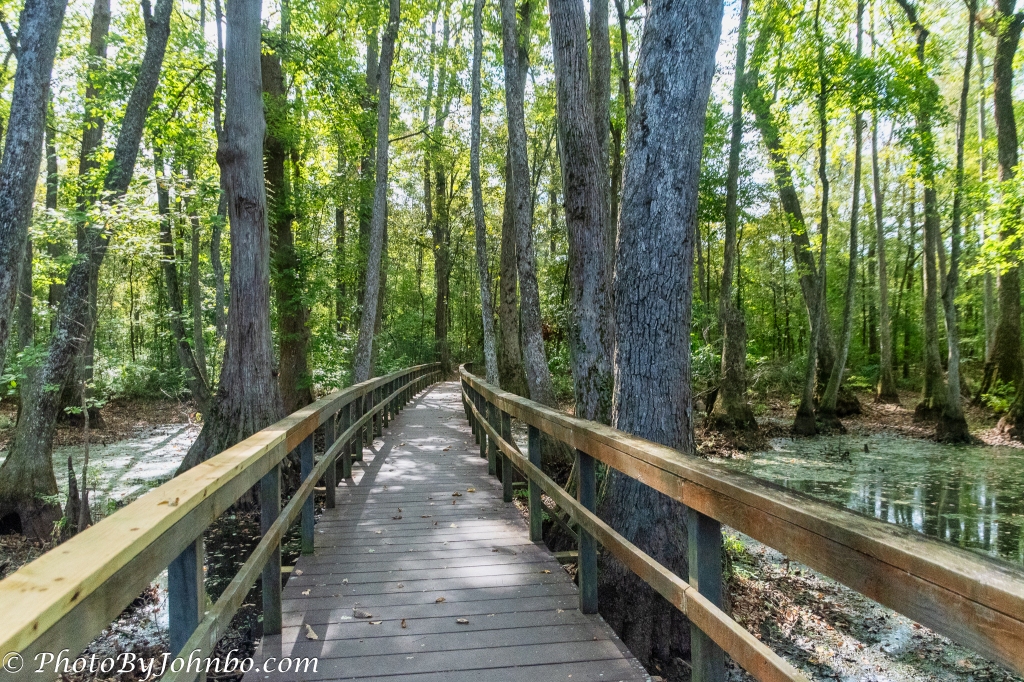
Canton, Mississippi.
I told the story of our trip on the Natchez Trace Parkway, a scenic drive we traveled from Canton to Tupelo in Mississippi. Our first stop found us at mile marker 122 on the parkway just outside Canton. Cypress Swamp is home to towering bald cypress and water tupelo trees, which are adapted to living in waterlogged soils. Though we didn’t see any wildlife on our visit, the swamp is also home to a variety of wildlife, including alligators, turtles, snakes, birds, and frogs.
Visitors to Cypress Swamp can step down the short stairway to walk along a 0.4-mile (.6 km) boardwalk trail that winds through the swamp, offering fascinating views of the trees shown in my opening photo.
Many years ago, the Pearl River flowed through this area. Over time, the river changed course, leaving behind a shallow area created by the deposition of sediments. During periods of low water, seedlings of water-tolerant cypress and tupelo trees were able to take root and grow.
The channel is slowly filling with silt and vegetation, and over time, bald cypress and water tupelo trees will be replaced by black willow, sycamore, and red maple trees.
Our first view of the swamp turnout was marked by the standard Natchez Trace Parkway sign. The small parking area was empty on the morning of our visit.
At the end of the boardwalk is a much shorter trail referenced in the placard in the photo above. You don’t need to cross the highway to walk the main trail unless you’d like a much more immersive experience.
The placard describes the changes taking place in the swamp and provides a description of the short trail that leads from the boardwalk. Bring comfortable shoes that you don’t mind getting dirty and clothing that you won’t mind getting wet if you plan to walk the trail.
Hikers and wildlife photographers might enjoy a trek on a longer trail that leads through the area. Directly across the Natchez Trace roadway from the swamp, you will find the Yockanookany Section of the Natchez Trace National Scenic Trail. This stretch of trail offers many sights, accessible via short side trails. The trail parallels and sometimes crosses the parkway roadbed, so please be careful to look for vehicle and bicycle traffic, especially at bridge crossings, where you must walk along the parkway road. The trail is over 25 miles (40 km) long, and it is an out-and-back style so hikers can choose how far to travel before returning to the trailhead. More details can be found on the National Park Service website here.
The wide base of the trees helps them stay rooted in the soggy soil of the swamp. Bald cypress trees are deciduous coniferous trees, meaning that they lose their leaves in the fall. They are adapted to living in waterlogged soils and can grow to be over 100 feet tall. Water tupelo trees are deciduous hardwood trees that are also adapted to living in waterlogged soils. They can grow to be over 100 feet tall and have bright red leaves in the fall.
After our visit to the Cypress Swamp, we continued north on the beautiful Natchez Trace Parkway. In addition to appropriate clothing and shoes for walking the trails, consider insect repellent and sunscreen. We didn’t have repellent, but we were lucky in that on this September morning, the insects were apparently sleeping in.
Be especially wary and on the watch for alligators. Stay on the trail and enjoy this truly special place.
John Steiner










This looks a wonderful place to explore. Not my idea of a swamp at all. Thanks for taking us along.
It is a fascinating place for us from our upper Midwest viewpoint.
That’s a cool place. Thanks for taking me along 🙂
It is, indeed. There are many interesting places along the Trace.
Your stunning pictures are a great way of sharing this beautiful place. I liked the water reflections.
We didn’t stay long, but our visit and walk were awesome.
😊
John, this is truly a fascinating place. Your photo led us on a hike around the area very nicely. Reading your account of the place made me think of Caddo Lake in Texas. It also has Cypress trees all over the area. Your photos are beautiful and give us a good account of the area.
Thanks, Egidio! It was well worth the stop.